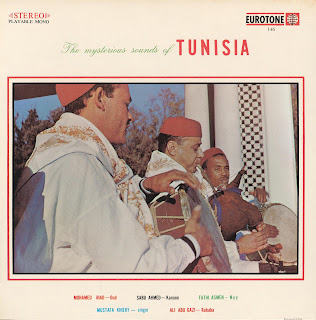The Mysterious Sounds of Tunisia
Tunisia has always been one of the centers of North African civilization. Carthage was the capital of a large country that came under the domination of the Roman Empire. Kairouan became a holy city, the center of the African Islamic world. A population probably of Celtic origin came successively under Roman domination, then Christian, and in 698 A.D., Arab. The very numerous Moslem refugees, driven out of Spain after 1492, brought to North Africa "Andalusian" music which was to play an important role there. Thereafter, in 1574, came the Turkish domination, and finally, in 1881, the French protectorate. The population of Tunisia is basically of Mediterranean origin but its religion is Islam. In the extreme south of the country, Tunisia touches the Negro world. Large Jewish communities have contributed to the formation of its culture. Tunisia has been a favored meeting ground where the most diverse civilizations came into contact and conflict, sometimes influenced one another and yet maintained, often for a long time, distinct and separate individualities. This little country of four million inhabitants is therefore of great interest for the history of music. It is often difficult, to be sure, to untangle the elements which have contributed to the formation of musical art that is as original as it is complex. We find in the folk music of the Berbers, in the South, pentatonic forms. The music called "Andalusian," attributed to the refugees who came from Spain, certainly found in Tunisia a soil which had already been prepared and in which it developed well. It belongs to a common Mediterranean fund — and often seems to be closer to the music of Sicily and Southern Italy than to Spanish music. As a matter of fact, it probably continues, in rather faithful fashion, the development of the ancient North African music and remains quite separate from the type of music which the Tunisians call "Oriental" and which came to them from Iran, brought first by the Arabs and later by the Turks. On the other hand, the way in which Tunisians sing choral music seems completely Mediterranean and Occidental.
We find again in the classical as well as in the folk music the diverse tendencies of Tunisian musical art. The Tunisians' love of music and the great efforts made first under the princes and more recently under the Republic to maintain the traditional musical art enables us to find still today some very important elements of an original musical culture whose roots stretch into the most distant past. For a better understanding of Arabic music, we must break it down into three basic components, namely, rhythm, melody, and tone color.
RHYTHM
In Arabic music, rhythm is of the utmost importance as it contributes to the exciting beat so essential for dancing. Most commonly used are the simple 2/4 or 4/4 beats, however, the 10/8, 12/8, and 9/4 rhythm structures are frequently used.
MELODY
Arabic melodies are usually simple and quite limited in range, (two octaves). They tend to go upward and reach a climax after which they decline to the tonic of the scale. Infrequent skips in the melody are characteristic.
TONE COLOR
Tone color refers to the timbre of the instruments used in Arabic music. We find that the variety of instruments used in the music of the Western World is limited in Arabic music to the Oud, Rebaba (violin), the Ney (flute), the Perbek (drum), and the Tambourine. Despite the limited variety, we find that Middle Eastern music is different and quite expressive.
ARABIC MODES and SCALES
Arabic music prides itself on a great variety of scales. Many are based on the major and minor scales as used in Europe and the rest of the Western World others contain 1/4 tone intervals not to be found in Western music. These modes or scales applying the 1/4 tone intervals contribute to the unique quality of Middle Eastern music.
Due to the nature of this type of music, we find no harmony or polyphony as we are accustomed to in Western music. The emphasis is on the melodic line as it moves through all different types of scales. It is not based on harmonic progressions, even the low register notes are almost identical to the notes of the melody, which is never played exactly as written, but rather depends on the individual artists' interpretation and skillful improvisations. There are approximately 80 different scales or modes used in Arabic music, some are basic scales, while others are derived from those basic scales.
All Arabic scales can be divided into three categories, namely, major scales, minor scales, and 1/4 tone Arabic scales.
IMPROVISATION
Improvisations are an all-important factor in Arabic music. The artist chooses a certain mode to start his improvisation. As he progresses he modulates from one mode to another in the classical style of Arabic music and ends his performance by returning to the original model. The improvisation on a set tempo is known as improvising on a "wehda".
It is hoped that the explanations furnished in these notes will add to the understanding of Arabic music and thus offer you many pleasurable hours of listening pleasure.





Comments
Post a Comment